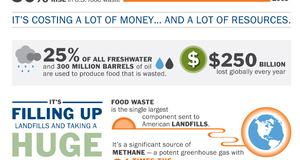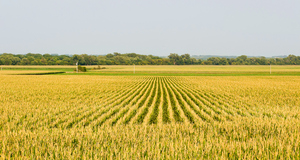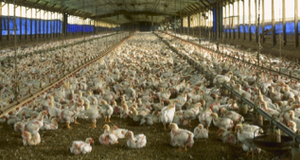From Interstate - Journal of International Affairs VOL. 2013/2014 NO. 1Food Security in the Contemporary World: Making Security Sustainable
KEYWORDS:
The concept of food security is dynamic; it has been changing to incorporate new ideas over the years since it was established. In this piece, I will argue that if cultural acceptability is to be added as a tenant of food security then so must sustainability. Cultural acceptability addresses the needs of various ethnicities, for example providing kosher foods for the Jewish population and halal foods for the followers of Islam. Since there is a new focus on the environment with initiatives such as the Kyoto Protocol, this piece concludes further that sustainability should also be an integral part of food security as a concept, if food security is to maintain its legitimacy as a concept. Changing demographics over the last two hundred years, especially since the advent of the Industrial Revolution, have altered the landscape of the developed world. Prior to the late 1800s, populations were more geographically scattered than today in an agrarian, agricultural setting. Following the technological and industrial advances that have occurred since this time, the majority of the populace moved to an urban environment. The migration to cities has changed the methods of providing sustenance to people. The structure is no longer that of a typical agrarian society . Instead, the food production and distribution systems are dominated by the corporate world which has led to the bulk of the food production system being in the hands of a few select companies.1 It is this "oligarchy" that causes a problem for the concept of food security in the urban environment. The five main tenets of the concept of food security are: quality; quantity; safety; palatability and cultural acceptability . Until the mid-1990s, food security was only defined by the trio of quality, quantity and safety. However since then, the concept of cultural acceptability has worked its way into the food security nexus. Culturally acceptability refers to the access to food stuffs that are acceptable for a designated population, for instance access to kosher food for the Jewish population.2 These elements encompass the major areas relating to food security, but there is an extra dimension that needs to be incorporated: sustainability. The inclusion of sustainability is necessary due to the changing geography of human society, with the ever-increasing focus on globalisation and corporate integration. Sustainability, for the purposes of this exploration, will be the inclusion of urban and peri-urban agriculture, that is those outside the city limits but not in rural (i.e. suburban areas), to supplement the prevalent food system in place today. The currently prevalent food system is taken to refer to the corporate-centred, large-scale food production system which predominates in the developed world. The developed world is usually conceptualised as exempt from issues of food security. Affluence and privilege supposedly indicate that people's "fundamental needs" have been met clothing, shelter, clean water and adequate food. However, this is not the case. For example , the Community Food Security Coalition's North American Urban Agriculture Committee lament s that 'one of the worst paradoxes in human history and one of the consequences of the economic structure of the current food system is hunger in the midst of plenty.3 It is this "hunger" that needs to be explored. For the following discussion, the concept of food security is the one defined by the International Food Policy Research Institute, which now covers the following:
Within the context of a First World urban environment, several facets take on increased importance. The concept of quantity, for the most part, is the least pressing issue. Generally, there is an available food supply that meets the necessary caloric intake for the population. Therefore, it is the other factors that come into sharp relief - the concepts of quality and acceptability being two of the most difficult to fulfil. The United States, for example, does not share the same problems as a famine-stricken Ethiopia of the early 1980s, but it has its own problems regarding nutrition. Meeting the nutritional requirements in an aggregate sense is not an issue, 'in the US, where food insecurity has been a persistent, if less severe problem, the concept of food security replaces the medical model of hunger and malnutrition during the 1980s.5 The issues of safety, quality and cultural acceptability consequently come into question with regard to food security in the First World urban environment. The practically oligarchic structure of the retail distribution and processing of the food supply to large urban conurbations in the developed world is of acute import ance to the planning and safety aspects of food security. The concentration of responsibility for the majority of production in very few raises concerns regarding the adverse effects that partial failure could hold for a large number of people. The socioeconomic implications for the state in question, both domestic and abroad , would be of unprecedent ed dimensions. At present, there is an issue of quality, in terms of nutritional value, that is of most pressing concern for the urban environment. Food in the current system, supplying the major retail establishments and food shops, is bound by their structures of economic productivity and profit In accordance with "capitalist motivations" these are put ahead of the inherent quality of the food supplied. On average the distance "from field to plate" in the US is between 1500 and 2500 miles. As a result of extensive transit periods - ranging from one week to two - a significant proportion of the produce is lost to spoilage. This consistent loss to spoilage represents approximately half of the crops gross yield.6 As a consequence, there is a distinct predisposition and inclination among farmers and crop producers- to opt for, not the most palatable or nutritious- produce, but those most resilient to the rigours and harsh conditions- of industrial harvesting and distribution.7 This is-a pressing issue, particularly in the US and Europe, and especially the United Kingdom. Medical News Today estimates that the volume of malnourished individuals- across the European Union amounts to a shocking fifty million.8 There have been several recent studies done on the topic of the prevalence of malnutrition, especially among the ageing sectors of the population. Up to ten per cent of those suffering from malnutrition are above the age of 65. Even more disturbingly, the proportion of individuals admitted to hospitals and nursing homes classified as- suffering from malnutrition rises to a staggering one third.9 This problem relates, in part, to two distinct obstacles-faced by the general public of First World urban environments. Firstly, the aforementioned problems faced by the currently prevalent structure of the food production industry, especially with regard to the overriding economic pragmatism of producers-, impacts other areas of the food security dynamic. These include the cultural acceptability and common availability of nutrient-rich produce. Secondly, the socio-cultural effects of the capitalist, consumerist drive, which continues to shape the Western economic system. The underlying economic ramifications of the Western market's capitalL-.t perspective have further implications for the aspects of food quality and quantity.10 The Americanised Western consumer culture L-. a particularly distinct trend, especially when taking into account the development of the "McCulture" that has taken on a life of its own in recent decades. In a modern urban environment, individuals are bombarded with the advertising and branding techniques of large corporations-, such as WalMart, Tesco, Morrisans and Publix:. On every corner, franchises are peddling their high-calorie, nutritionally lacking, "fast foods-". Orr the topic of nutritional responsibility such corporations argue that it is a free choice consumers make to partake in the commodities that they supply. This, however, has been opposed on several fronts, most prominently on that of the addictive nature of their products. There have been several studies conducted which have found that it is less a question of "gluttony and fecklessness" that contributes to the consumer choice to partake in fast food, and more due to the addictive nature of the food itself: something conspicuously overlooked in the multi-nationals' arguments in support of free choice.11 However, lobbying stifles the initiative of policy makers- to construct policies that would benefit the population as a whole. On the regulatory level, this is something that needs to be taken into consideration. Framed in the traditional paradigm of free choice, this makes for a fairly grim outlook for those concerned about their nutritional and cultural "rights" in terms of food security. This is not to say that individual consumer choices are not a major factor in maintaining their own health and choice of food, but it is a concern for the governing institution s and requires further scrutiny - there is need for further inquiry into the nature of the food on offer and the chains that supply it. The concept of cultural acceptability as an addition to the food security nexus is a relatively recent phenomenon. The cultural pluralism stemming from globalisation and the "shrinking" of the world gave rise to this previously overlooked factor. In a similar vein, the issue of sustainability needs to work its way into the conception of food security when considering the progression of globalisation and the environmental impacts of the modern lifestyle on the planet. The promotion of sustainable Urban and peri-urban agricultural projects will reduce the impact on the environment, reducing the carbon footprint of the traditional food production system as well as reducing the mileage of the distribution process. The practices of urban agricultural projects also span the full length and breadth of the concept of food security. In addition to the conscious decisions concerning caloric intake that these projects further, they address the variables of nutritional content and palatability. Furthermore, they reduce concerns over toxic contaminants and cater to the cultural proclivities of those who seek to express culinary consciousness through the food they eat. Currently there are a variety of initiatives in place in large urban environments that help to contribute to the quality of the nutritional intake of those who engage in them. The Community Food Security Coalition has compiled a lL'>ot f activities that would be included under the umbrella heading of Urban Agriculture which includes 'fish farms, farm animals at public housing sites, municipal compost facilities, schoolyard greenhouses , restaurant-supported salad gardens, backyard orchards, rooftop gardens and beehives, window box gardens and much more'.12 In Are We Planning for Sustainable Development?, the authors review the planning agenda of urban agriculture across 105 communities in the US and find that 'many communities are now embracing the concept [ of urban agriculture}, but their planners may only have a superficial understanding of how t o translate it into practice.13 Structural failings of this ldnd need to be highlighted by policymakers as coherent approaches to practice are essential for an integrated approach to food security in the urban environment The inclusion of sustainability into food security will bring to the fore of policymakers' consciousness the need for such practical applicable methods for the promotion of urban agriculture. The UK has a vibrant tradition of allotments stretching back to the Medieval and Early Modern periods with the first references dating back to the 1500s.14 Allotments are plots of land allocated to individuals either for rent or as part of tied employment for the cultivation of crops for individual, non-commercial use. In such an environment that has a distinct tradition of allotments and gardening developing policies, catering to the strength of the historical tradition is the most advisable approach. This raises other issues that need to be taken into account, such as soil quality. To illustrate, a study conducted at the Walker Road allotment in Newcastle-upon-Tyne found that the proximity of the allotment gardens to a waste plant in the vicinity lead to heavy-metal contamination of the soil that could potentially pose a risk to allotment holders at this location. If a concerted effort is made to include sustainability as a defining feature of food security, issues this will need to be taken into consideration by city planners before expanding or initiating new projects. Such forethought will prevent potentially hazardous problems.15Continued on Next Page » Suggested Reading from Inquiries Journal
Inquiries Journal provides undergraduate and graduate students around the world a platform for the wide dissemination of academic work over a range of core disciplines. Representing the work of students from hundreds of institutions around the globe, Inquiries Journal's large database of academic articles is completely free. Learn more | Blog | Submit Latest in Environmental Studies |



















